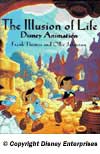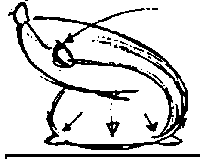That Poor Misunderstood Sack of Flour
Almost anyone who has ever taken a course in animation formally in a classroom or on-line has probably encountered the "Half-Filled Sack of Flour" exercise. To the best of my knowledge this poor misunderstood little fellow originated from training that was developed at the Disney Studios. It was written about and popularized in the classic book The Illusion of Life: Disney Animation
written by Frank Thomas and Ollie Johnston.

I refer to it as that poor misunderstood sack of flour because the exercise has been passed down so many times by so many different sources and reinterpreted so many times that the poor little guy often doesn't get treated very nicely. The flour sack is perhaps one of the animator's best friends and learning exercises and one of my personal favorites so I want to try to take this discussion back as close to the original context as I can, and perhaps shed some new light on an old friend.
In the 1930’s, the artists at the Disney Studios were encouraged to explore and discover this new art of animation. And from a practical point of view, they began to codify their discoveries until they had evolved into accepted “rules of the trade” often referred to today as the fundamental principals of animation.
One of their most important discoveries evolved into the principle named Squash and Stretch. When things move in the real world, unless they are rigid objects and not organic, they tend to deform. The terms coined to describe naturally occurring shape deformations were squash and stretch. And just as you would have expected, having made these observations, the early Disney artists really pushed the envelope in exploring how they could squash and stretch everything.
What I find to be often misunderstood about this naturally occurring deformation is that it really is just another way of describing how a body actually moves, the expansion and contraction of muscles, skin and tissues. Essentially, natural distortion and deformation is bounded by the physical causes of those deformations, muscles, skin and tissues have limits. You can’t just deform a shape without some connection to the underlying forces and physical limits associated with natural movement. Some license for exaggeration is appropriate in cartooning but particularly when an artist is first learning to animate they need to be grounded in the rules before they totally break them.

But trying to learn and practice natural movement without having to deal with the extreme complexities of a person or an animal required a surrogate. A rubber ball really wasn’t organic enough, so somewhere along the way; some animation pioneer stumbled on to the half-filled sack of flour. It may have had its origins in life drawing as an analogy to the twisting human torso or perhaps it was just a close approximation to a single muscle. The key point being that it deforms naturally like an organic shape and it maintains a constant volume which provides a natural limitation to the distortions and deformations. With a little imagination the end tabs of the flour sack could be manipulated to act like the little guy's limbs.
So the primary reason for the half-filled flour sack is as a simplified learning platform for understanding natural deformations in movement and dealing with the inherent limitations. The additional imparting of character, personality and emotions to the flour sack is a secondary part of the exercise that evolved later. All too often animation students are introduced to this exercise as a lesson in learning to develop and show character and emotions in a simple object and don’t truly understand the primary value of the exercise. The poor misunderstood little flour sack gets a quick pass as a simple and pathetic little character and is often overlooked as a real training ground for understanding forces, deformation, and fundamental organic movement.
written by Frank Thomas and Ollie Johnston.

I refer to it as that poor misunderstood sack of flour because the exercise has been passed down so many times by so many different sources and reinterpreted so many times that the poor little guy often doesn't get treated very nicely. The flour sack is perhaps one of the animator's best friends and learning exercises and one of my personal favorites so I want to try to take this discussion back as close to the original context as I can, and perhaps shed some new light on an old friend.
In the 1930’s, the artists at the Disney Studios were encouraged to explore and discover this new art of animation. And from a practical point of view, they began to codify their discoveries until they had evolved into accepted “rules of the trade” often referred to today as the fundamental principals of animation.
One of their most important discoveries evolved into the principle named Squash and Stretch. When things move in the real world, unless they are rigid objects and not organic, they tend to deform. The terms coined to describe naturally occurring shape deformations were squash and stretch. And just as you would have expected, having made these observations, the early Disney artists really pushed the envelope in exploring how they could squash and stretch everything.
What I find to be often misunderstood about this naturally occurring deformation is that it really is just another way of describing how a body actually moves, the expansion and contraction of muscles, skin and tissues. Essentially, natural distortion and deformation is bounded by the physical causes of those deformations, muscles, skin and tissues have limits. You can’t just deform a shape without some connection to the underlying forces and physical limits associated with natural movement. Some license for exaggeration is appropriate in cartooning but particularly when an artist is first learning to animate they need to be grounded in the rules before they totally break them.

But trying to learn and practice natural movement without having to deal with the extreme complexities of a person or an animal required a surrogate. A rubber ball really wasn’t organic enough, so somewhere along the way; some animation pioneer stumbled on to the half-filled sack of flour. It may have had its origins in life drawing as an analogy to the twisting human torso or perhaps it was just a close approximation to a single muscle. The key point being that it deforms naturally like an organic shape and it maintains a constant volume which provides a natural limitation to the distortions and deformations. With a little imagination the end tabs of the flour sack could be manipulated to act like the little guy's limbs.
So the primary reason for the half-filled flour sack is as a simplified learning platform for understanding natural deformations in movement and dealing with the inherent limitations. The additional imparting of character, personality and emotions to the flour sack is a secondary part of the exercise that evolved later. All too often animation students are introduced to this exercise as a lesson in learning to develop and show character and emotions in a simple object and don’t truly understand the primary value of the exercise. The poor misunderstood little flour sack gets a quick pass as a simple and pathetic little character and is often overlooked as a real training ground for understanding forces, deformation, and fundamental organic movement.

3 Comments:
Wow, thanks for the history of the flour sack! I'm currently going to school for 3D animation and I just began playing with the flour sack! It's amazing how so many intrinsical lessons link back to Disney's Animators. I've been told many times to check out "Illusion of Life" and now I'll definitely have to get a copy!
Thanks again!
well, thanks, very friendly and usefull idea.
I must follow this link more often. Interesting thoughts you seem to have and I appreciate you are sharing this with all of us.
Dan Metalmadcat
Post a Comment
<< Home